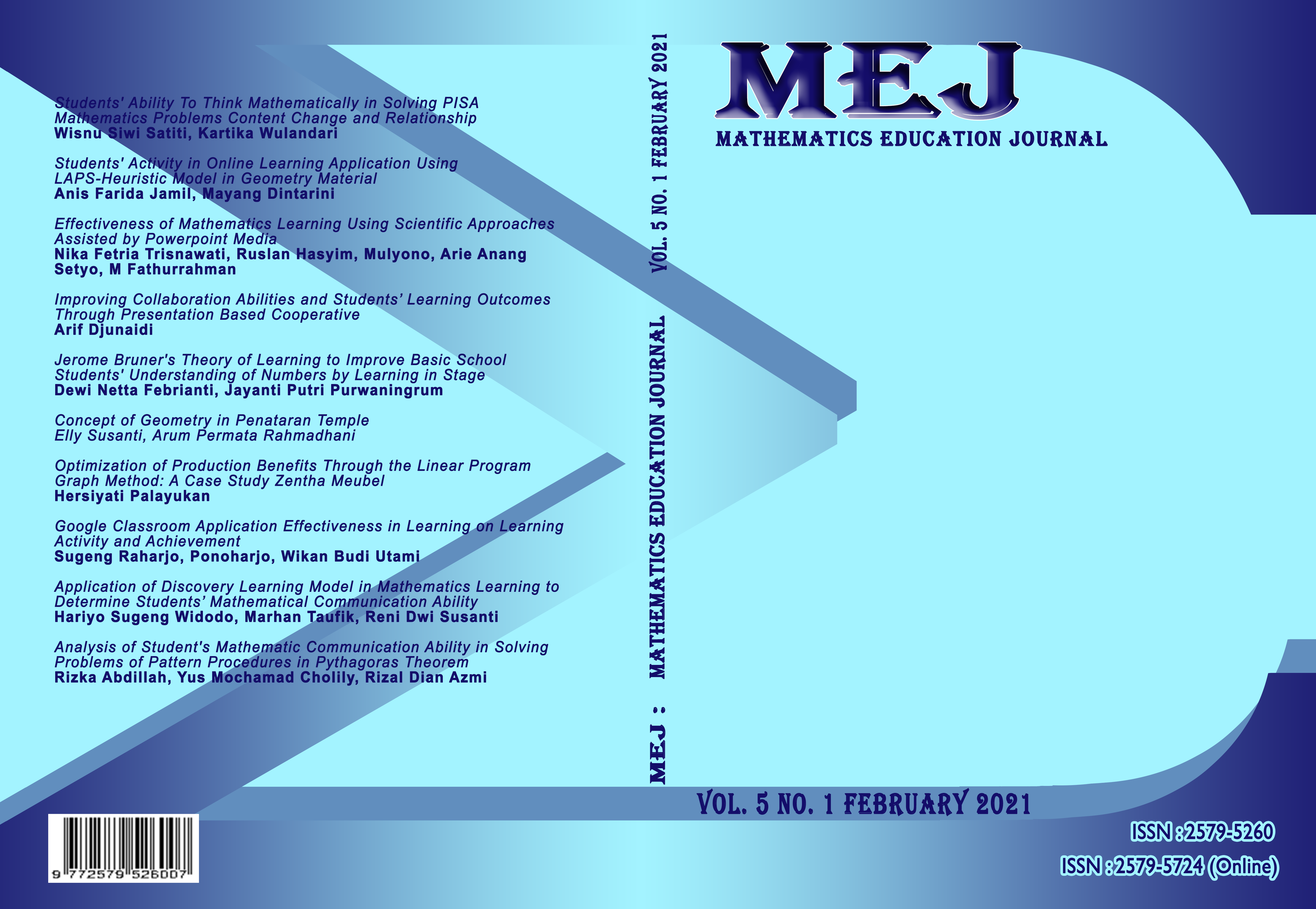Students' Ability To Think Mathematically in Solving PISA Mathematics Problems Content Change and Relationship
DOI:
https://doi.org/10.22219/mej.v5i1.14380Keywords:
Mathematical thinking, PISA items, ScaffoldingAbstract
This article describes students’ mathematical-thinking process in solving PISA-model mathematics -problems. Mathematical-thinking is not only important for academic succes, but is also esssential for developing mathematical reasoning and critical thinking habits in sustainable development for creating better life. In order to achieve the research aims, we used a qualitative approach with descriptive methods. Data were collected using mathematical activities adapted from PISA items. Three students’ works that represent each level of mathematical ability were selected for in-depth analysis. The findings shows that students’ mathematical-thinking ability in solving PISA-model mathematics-problems is determined by how the students go beyond phases of mathematical-thinkng proses (Entry, Attack, Review). Students can solve problems correctly if they are able to go through all phases, although not all aspects of each phase are fulfilled. If students fail in the Entry phase, it is certain that they cannot go through the next two phases properly (Attack and Review).
Downloads
References
Anwar, L., Budayasa, I. K., Amin, S. M., & de Haan, D. (2012). Eliciting Mathematical Thinking of Students through Realistic Mathematics Education. IndoMS, J.M.E, 3(1), 55–70.
Breen, S., & O'Shea, A. (2010). Mathematical thinking and task design. Irish Mathematical Society Bulletin, (66), 39-49.
Devlin, K. (2019). How technology has changed what it means to think mathematically. In Interdisciplinary Perspectives on Math Cognition (pp. 53-78). Springer, Cham.
Fatimah, S., Muhsetyo, G., & Rahardjo, S. (2019). Proses Berpikir Tingkat Tinggi Siswa SMP Dalam Menyelesaikan Soal Pisa dan Scaffoldingnya. Jurnal Kajian Pembelajaran Matematika, 3(1), 24–33.
Kahar, M. S. (2017). Analisis Kemampuan Berpikir Matematis Siswa SMA Kota Sorong terhadap Butir Soal dengan Graded Response Model. Tadris: Jurnal Keguruan Dan Ilmu Tarbiyah, 02(1), 11–18.
Khamidah, K., & Suherman. (2016). Proses Berpikir Matematis Siswa dalam Menyelesaikan Masalah Matematika Ditinjau dari Tipe Kepribadian Keirsey. Al-Jabar: Jurnal Pendidikan Matematika, 7(2), 231–248.
Mason, J., Burton, L., & Stacey, K. (2010). Thinking Mathematically (2nd ed.). Pearson Education Limited.
Nasriadi, A., & Sari, I. K. (2017). KEMAMPUAN SISWA MEMECAHKAN SOAL SETARA PISA KONTEKS PEKERJAAN : STUDI PENGEMBANGAN SOAL PISA KONTEN CHANGE AND RELATIONSHIP. Jurnal Pendidikan Matematika RAFA, 3(2), 223–238.
OECD. (2013). PISA 2012 assessment and analytical framework: Mathematics, reading, science, problem solving and financial literacy. Paris. https://doi.org/10.1787/9789264190511-en
OECD. (2013). PISA 2012 Items for Release. Paris: OECD Publishing.
OECD. (2014). PISA 2012 Result in Focus: What 15-years-olds know and what they can do with what they know. Paris: OECD Publishing.
Pratiwi, D. A., Trapsilasiwi, D., Oktavianingtyas, E., Sunardi, & Murtikusuma, R. P. (2019). Level Literasi Matematika Siswa dalam Menyelesaikan Soal PISA Konten Change and Relationship Berdasarkan Gaya Kognitif. Kadikma, 10(3), 1–14.
Satiti, W. S., & Verdianingsih, E. (2019). Penggunaan Scaffolding untuk Mengatasi Kesulitan Problem Solving Mahasiswa Calon Guru. JMPM: Jurnal Matematika Dan Pendidikan Matematika, 4(2), 113–127. https://doi.org/https://doi.org/10.26594/jmpm.v4i2.1680
SEAMEO-RECSAM. (2017). SEAMEO Basic Education Standards (SEA-BES): Common Core Regional Learning Standards (CCRLS) in Mathematics and Science. (D. D. Mangao, N. J. Ahmad, & M. Isoda, Eds.). Penang, Malaysia: Unit Publikasi SEAMEORECSAM.
Sepeng, P. (2013). Use of unrealistic contexts and meaning in word problem solving: a case of second language learners in Township schools. International Journal of Research in Mathematics, 1(1), 8–14.
Stacey, K. (2015). The international assessment of mathematical literacy: PISA 2012 framework and items. In The 12th International Congress on Mathematical Education (pp. 771–790). Springer, Cham.
Sugiyono. (2018). Metode Penelitian Pendidikan (Pendekatan Kuantitatif, Kualitatif, dan R & D). Bandung: Alfabeta.
Wijaya, A., Van den Heuvel-Panhuizen, M., Doorman, M., & Robitzsch, A. (2014). Difficulties in solving context-based PISA mathematics tasks: an analysis of students’ errors. The Mathematics Enthusiast, 11(3), 541–554.
Downloads
Published
Issue
Section
License
Copyright (c) 2021 Wisnu Siwi Satiti

This work is licensed under a Creative Commons Attribution-ShareAlike 4.0 International License.
Authors who publish with MEJ (Mathematics Education Journal) agree to the following terms:
For all articles published in MEJ, copyright is retained by the authors. Authors give permission to the publisher to announce the work with conditions. When the manuscript is accepted for publication, the authors agree to automatic transfer of the publishing right to the publisher.
Authors retain copyright and grant the journal right of first publication with the work simultaneously licensed under a Creative Commons Attribution-ShareAlike 4.0 International License that allows others to share the work with an acknowledgment of the work's authorship and initial publication in this journal.
Authors are able to enter into separate, additional contractual arrangements for the non-exclusive distribution of the journal's published version of the work (e.g., post it to an institutional repository or publish it in a book), with an acknowledgment of its initial publication in this journal.
Authors are permitted and encouraged to post their work online (e.g., in institutional repositories or on their website) prior to and during the submission process, as it can lead to productive exchanges, as well as earlier and greater citation of published work (See The Effect of Open Access).

This work is licensed under a Creative Commons Attribution-ShareAlike 4.0 International License.










